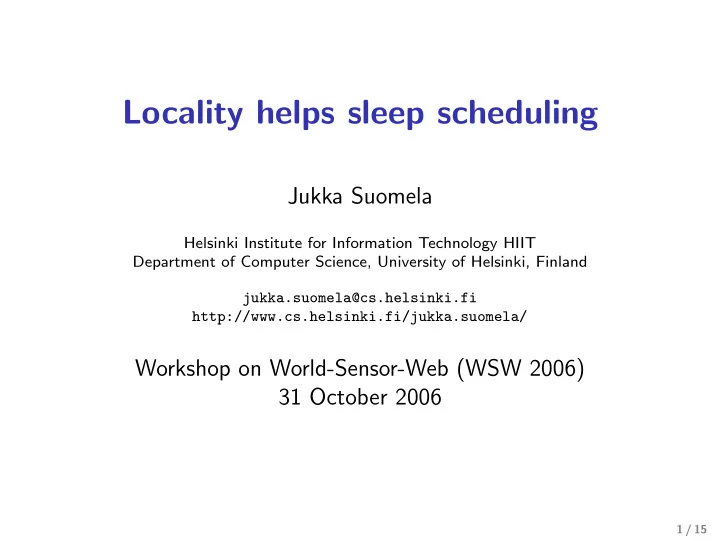

Locality helps sleep scheduling Jukka Suomela Helsinki Institute for Information Technology HIIT Department of Computer Science, University of Helsinki, Finland jukka.suomela@cs.helsinki.fi http://www.cs.helsinki.fi/jukka.suomela/ Workshop on World-Sensor-Web (WSW 2006) 31 October 2006 1 / 15
Sleep scheduling problem ◮ Given: a sensor network ◮ Assumption: there may be some redundant nodes ◮ Objective: find a sleep schedule that maximises the lifetime of the network ◮ Constraints: ◮ Energy-constrained nodes ◮ At any point of time, a node can sleep only if it is redundant 2 / 15
Redundancy graphs ◮ Focus: pairwise redundancy of the nodes ◮ Example: if v 1 is active then v 2 may be asleep and vice versa (e.g., sensors are close to each other) v 1 v 3 v 2 v 4 v 5 v 6 v 7 3 / 15
Redundancy graphs ◮ Redundancy relations can be represented as a graph v 1 v 3 v 2 v 4 v 5 v 6 v 7 4 / 15
Redundancy graphs ◮ A valid set of active (nonsleeping) nodes = a dominating set in the redundancy graph ◮ Two examples; red = active, white = asleep: v 1 v 1 v 3 v 3 v 2 v 2 v 4 v 5 v 4 v 5 v 6 v 7 v 6 v 7 5 / 15
Redundancy graphs ◮ Sleep schedule = a time interval for each dominating set ◮ No single node is active for more than 1 unit of time ◮ An example of a sleep schedule of length 2: v 1 v 1 v 3 v 3 v 2 v 2 v 4 v 5 v 4 v 5 v 6 v 7 v 6 v 7 Active for 1 time unit Active for 1 time unit 6 / 15
Domatic partition ◮ One possible solution: find a domatic partition ◮ That is, partition the nodes into disjoint dominating sets (maximum number of such sets = domatic number) ◮ Assign 1 time unit to each such set ◮ Length of sleep schedule = number of such sets v 1 Green nodes are v 3 a dominating set and red nodes are another v 2 v 4 v 5 disjoint dominating set v 6 v 7 7 / 15
Domatic partition ◮ However, domatic partition does not necessarily give an optimal sleep schedule ◮ Example: ring of 5 nodes (neighbours pairwise redundant) ◮ Domatic number is 2 ◮ We obtain a sleep schedule of length 2: 1 1 8 / 15
Fractional domatic partition ◮ We have to allow fractional solutions ◮ This is an LP relaxation of domatic partition (fractional domatic partition) ◮ An optimal sleep schedule of length 5 / 2: 1 / 2 1 / 2 1 / 2 1 / 2 1 / 2 9 / 15
Fractional domatic partition ◮ Sleep scheduling with pairwise redundancy = fractional domatic partition of the redundancy graph ◮ There is a lot of research on finding domatic partitions (and more general set cover packings, set K -cover), but little research on the fractional versions ◮ Unfortunately, both domatic partition and fractional domatic partition in general graphs are hard to approximate within factor (1 − ǫ ) ln | V | ◮ Solution: observe that realistic redundancy graphs are not arbitrary graphs ◮ We focus on what we call ( d , N )-local graphs 10 / 15
Local graphs ◮ Nodes are points in a d -dimensional space 11 / 15
Local graphs ◮ Nodes are points in a d -dimensional space ◮ No more than N nodes in any unit disk 12 / 15
Local graphs ◮ Nodes are points in a d -dimensional space ◮ No more than N nodes in any unit disk ◮ No edges longer than 1 unit 13 / 15
Fractional domatic partition in local graphs Main result: ◮ Polynomial-time approximation scheme (PTAS) for fractional domatic partition in local graphs ◮ That is, for any ǫ > 0, there is a polynomial-time (1 + ǫ )-approximation algorithm Techniques: ◮ Garg-K¨ onemann LP approximation scheme: ◮ Problem reduced to minimising weighted dominating set ◮ Divide-and-conquer technique based on modular grids: ◮ Multiple partitions of the plane ◮ Solve weighted dominating set optimally in each cell ◮ Nodes near borders of the cells may do extra work ◮ However, at least one of the partitions is good: there is not too much weight near the borders 14 / 15
Summary ◮ Focus on pairwise redundancy ◮ Sleep scheduling in sensor networks = fractional domatic partition in redundancy graphs ◮ Hard to solve or approximate in general ◮ Focus on ( d , N )-local graphs ◮ Polynomial-time approximation scheme (PTAS) for fractional domatic partition in local graphs ◮ Assumptions on locality help with sleep scheduling Jukka Suomela Helsinki Institute for Information Technology HIIT Department of Computer Science, University of Helsinki, Finland jukka.suomela@cs.helsinki.fi http://www.cs.helsinki.fi/jukka.suomela/ 15 / 15
Recommend
More recommend